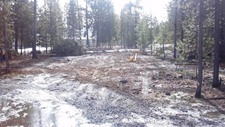The NAHB (National Association of Home Builders) recently published an article to provide advice on the causes of structural issues. The article, “Lessons Learned From 10,000 Structural Claims”, was developed from a presentation given to the NAHB Building Product Issues Committee last September by its author, Walt Keaveny.
There was some information in the article which utterly astounded me. According to Keaveny, 25% of all U.S. homes will experience some structural distress over their lifetime, and 5% will experience major structural difficulties. Even more telling is some 80% of structural claims are caused by movement of the building foundation which is due to movement of underlying soils.
Now to me, it is seemingly unfathomable so many homes would have foundation issues!
Sadly, probably even less care is given by building owners and contractors to the soils at the sites where they will be constructing new pole buildings. Far too often the only consideration is to scrape off any sod where the building will be placed, and build!
In my over three decades in the post frame industry, I have seen more than a few pole buildings whose eave lines zig-zag up and down due to one or more columns having shifted after the building was completed.
 In areas where soils are weak or expansive, I have listened to many complaints by potential building owners whose Building Officials are requiring geotechnical investigations to assess the strength of the soil. While having an engineer perform these tests is not inexpensive, in comparison to costs of a building settling, spending a few dollars up front in prevention, is a lot better than having to try to cure the problem once it exists.
In areas where soils are weak or expansive, I have listened to many complaints by potential building owners whose Building Officials are requiring geotechnical investigations to assess the strength of the soil. While having an engineer perform these tests is not inexpensive, in comparison to costs of a building settling, spending a few dollars up front in prevention, is a lot better than having to try to cure the problem once it exists.
The clues to a good pole building foundation, are knowing with a high degree of certainty the actual soil bearing capacity and having footings below the columns which are adequate in area to be able to distribute the weight of the building (plus associated loads like snow) across the soil. It also means adequate site preparation, at a minimum:
Remove all sod and vegetation.
- For idea site preparation, remove topsoil and stockpile for later use in finish grading. In frost prone areas, remove any clays or silty soil from within the future building “footprint”.
- Replace subsoil removed from around building with granulated fill to help drain subsurface water from building.
- Distribute all fill, large debris free (no pit run), uniformly around site in layers no deeper than six inches.
- Compact each layer to a minimum 90% of a Modified Proctor Density before next layer is added. Usually, adequate compaction takes more than driving over fill with a dump truck, or earth moving equipment.
- When any building portion sits on fill, rest columns, as well as any concrete encasement, on or in undisturbed soil. In many cases, building inspectors will require a soils engineer to confirm compaction adequacy on filled sites. Soils engineers can be expensive, but are even more costly when called in to do analysis “after the fact”.
Most importantly, be certain to know local Building Department requirements before starting to move dirt!






